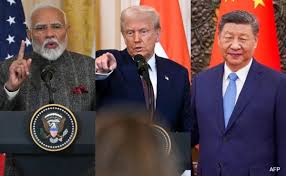Trump, China, and Tariffs: A Dangerous Dance on the Global Stage

Donald Trump’s return to political dominance has reignited a complex and often contradictory narrative around his stance on China. On one hand, his rhetoric sounds tough—filled with calls for tariffs, decoupling, and economic self-reliance. On the other hand, many analysts believe Trump is strategically “soft” on China in areas that matter most geopolitically, such as military posturing or coordinated global pressure. This dual approach is not only confusing markets but is also reshaping international relationships in significant ways.
The tariffs, of course, are real—and rising. Trump has expanded duties on a wide range of Chinese imports, claiming it’s necessary to protect American manufacturing and counter “unfair” trade practices. From electronics to raw materials, Chinese goods are becoming more expensive in the U.S., putting pressure on supply chains and businesses that depend on cheap imports. Yet Trump often avoids direct confrontation on issues like Taiwan or the South China Sea, choosing instead to focus on economic leverage over military or diplomatic escalation.
This paradox has led to an evolving relationship with China—tense but not openly hostile. Critics argue that the tariffs are more about domestic politics than foreign policy. By blaming China for America’s economic woes, Trump taps into voter frustration while avoiding the full-scale confrontation that might trigger unpredictable outcomes. It’s a calculated risk: punish economically without burning diplomatic bridges entirely.
India finds itself in a delicate position in this dynamic. As a strategic rival to China and a key U.S. partner, India has gained favor under Trump’s Indo-Pacific vision. Yet, Trump’s tariffs and economic nationalism also extend to Indian exports, creating friction. While India enjoys U.S. support in its border tensions with China, the transactional nature of Trump’s diplomacy means even allies like India can’t take preferential treatment for granted.
Russia, meanwhile, watches this dance with quiet satisfaction. The growing rift between the U.S. and China offers Russia more room to maneuver diplomatically and economically. Moscow has deepened ties with Beijing, especially in energy and defense, but also sees India as a historical ally. Trump’s ambiguous China policy, in effect, gives Russia the space to play both sides and strengthen its own position in a multipolar world.
The global implications are becoming more visible. Supply chains are shifting. Countries like Vietnam, Mexico, and even India are benefiting from companies seeking alternatives to China. But this decoupling isn’t complete—China remains deeply embedded in global trade. Trump’s policies, while aggressive, haven’t dismantled the trade web, just rerouted parts of it. It’s a sign that economic separation is far more complex than political slogans suggest.
Looking ahead, if Trump continues to lead with tariffs and transactional diplomacy, alliances will become more fluid. India may have to hedge between U.S. support and its own independent path, especially if Russia and China deepen their cooperation. The U.S., for all its power, risks alienating both friends and rivals if it’s seen as unpredictable or self-serving.
In the end, Trump’s strategy on China—tough in tone, selective in pressure—isn’t just about Beijing. It’s about shaping a new global order where old alliances are tested, economic nationalism rises, and geopolitical lines are redrawn. For countries like India and Russia, the challenge will be navigating this uncertainty without becoming pawns in someone else’s power game.